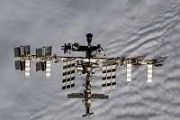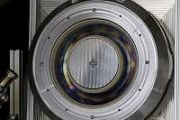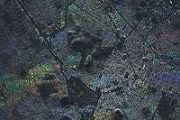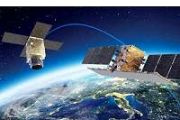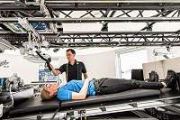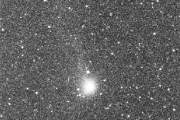
Copernical Team
Johns Hopkins study shows how scientists can use black holes as supercolliders
 As federal funding cuts impact decades of research, scientists could turn to black holes for cheaper, natural alternatives to expensive facilities searching for dark matter and similarly elusive particles that hold clues to the universe's deepest secrets, a new Johns Hopkins study of supermassive black holes suggests.
The findings could help complement multi-billion-dollar expenses and dec
As federal funding cuts impact decades of research, scientists could turn to black holes for cheaper, natural alternatives to expensive facilities searching for dark matter and similarly elusive particles that hold clues to the universe's deepest secrets, a new Johns Hopkins study of supermassive black holes suggests.
The findings could help complement multi-billion-dollar expenses and dec Huge planet discovered orbiting tiny star puzzles scientists
 Astronomers announced Wednesday they have discovered a massive planet orbiting a tiny star, a bizarre pairing that has stumped scientists.
Most of the stars across the Milky Way are small red dwarfs like TOI-6894, which has only 20 percent the mass of our Sun.
It had not been thought possible that such puny, weak stars could provide the conditions needed to form and host huge planets.
Astronomers announced Wednesday they have discovered a massive planet orbiting a tiny star, a bizarre pairing that has stumped scientists.
Most of the stars across the Milky Way are small red dwarfs like TOI-6894, which has only 20 percent the mass of our Sun.
It had not been thought possible that such puny, weak stars could provide the conditions needed to form and host huge planets. How does life rebound from mass extinctions
 If you're an animal living through a mass extinction, it's best to be one that's found a unique way to make a living.
A new analysis of the species that lived or died out in the wake of the asteroid that killed the dinosaurs has revealed unexpected patterns that counter our prevailing theories of survival in the wake of mass extinctions.
A team of scientists with the University of Ch
If you're an animal living through a mass extinction, it's best to be one that's found a unique way to make a living.
A new analysis of the species that lived or died out in the wake of the asteroid that killed the dinosaurs has revealed unexpected patterns that counter our prevailing theories of survival in the wake of mass extinctions.
A team of scientists with the University of Ch Cosmic Himalayas quasar cluster defies explanation
 A newly discovered cluster of eleven quasars has shattered the previous record of five. Rather than being associated with a dense group of galaxies, these quasars sit on the boundary between two groups of galaxies. This structure, dubbed the "Cosmic Himalayas," cannot be explained by conventional theories, forcing astronomers to rethink the formation scenarios for quasars.
Quasars are some
A newly discovered cluster of eleven quasars has shattered the previous record of five. Rather than being associated with a dense group of galaxies, these quasars sit on the boundary between two groups of galaxies. This structure, dubbed the "Cosmic Himalayas," cannot be explained by conventional theories, forcing astronomers to rethink the formation scenarios for quasars.
Quasars are some Millions of new solar system objects to be found and 'filmed in technicolor'
 A group of astronomers from across the globe, including a team from the University of Washington and led by Queen's University Belfast, have revealed new research showing that millions of new solar system objects will be detected by a brand-new facility, which is expected to come online later this year.
The NSF-DOE Vera C. Rubin Observatory is set to revolutionize our knowledge of the sola
A group of astronomers from across the globe, including a team from the University of Washington and led by Queen's University Belfast, have revealed new research showing that millions of new solar system objects will be detected by a brand-new facility, which is expected to come online later this year.
The NSF-DOE Vera C. Rubin Observatory is set to revolutionize our knowledge of the sola Maritime Launch and T-Minus Engineering Announce Plans for Hypersonic Suborbital Launches from Spaceport Nova Scotia
 Maritime Launch Services Inc. (Cboe CA: MAXQ) (OTCQB: MAXQF) is pleased to announce a new collaboration with T-Minus Engineering B.V., a leading Dutch aerospace company, to launch the Barracuda, a hypersonic test platform, from Spaceport Nova Scotia in October 2025.
This mission will represent the next step in advancing Spaceport Nova Scotia's suborbital and hypersonic testing capabilities
Maritime Launch Services Inc. (Cboe CA: MAXQ) (OTCQB: MAXQF) is pleased to announce a new collaboration with T-Minus Engineering B.V., a leading Dutch aerospace company, to launch the Barracuda, a hypersonic test platform, from Spaceport Nova Scotia in October 2025.
This mission will represent the next step in advancing Spaceport Nova Scotia's suborbital and hypersonic testing capabilities Fighter pilot takes next giant step for India's space plans
 Astronaut Shubhanshu Shukla blasts off into space next week as the first Indian to join the International Space Station (ISS), bearing with him New Delhi's dreams of its own manned space flight.
An airforce fighter pilot, 39-year-old Shukla is joining a four-crew mission launching from the United States with private company Axiom Space, aboard a SpaceX Crew Dragon capsule.
He will become
Astronaut Shubhanshu Shukla blasts off into space next week as the first Indian to join the International Space Station (ISS), bearing with him New Delhi's dreams of its own manned space flight.
An airforce fighter pilot, 39-year-old Shukla is joining a four-crew mission launching from the United States with private company Axiom Space, aboard a SpaceX Crew Dragon capsule.
He will become ESA’s new asteroid hunter opens its eye to the sky

The European Space Agency’s (ESA) newest planetary defender has opened its ‘eye’ to the cosmos for the first time. The Flyeye telescope’s ‘first light’ marks the beginning of a new chapter in how we scan the skies for new near-Earth asteroids and comets.
Why MTG-S1 is a nowcasting game-changer

The Meteosat Third Generation Sounder satellite (MTG-S) will generate a completely new type of data product, especially suited to nowcasting severe weather events. Here are five ways in which Europe’s latest weather satellite will change how we forecast weather.
Reusable Chinese rocket soft-lands in the ocean in a new test
This request seems a bit unusual, so we need to confirm that you're human. Please press and hold the button until it turns completely green. Thank you for your cooperation!
Press and hold the button
If you believe this is an error, please contact our support team.
185.132.36.159 : 9bb53bdd-c2e2-48a1-af37-19063924









